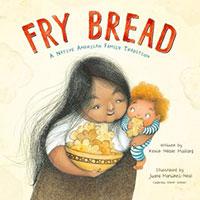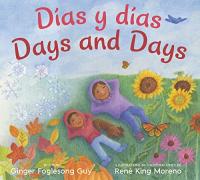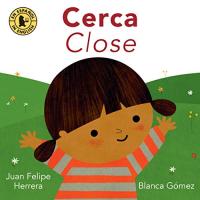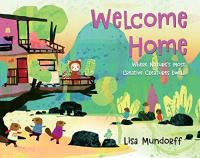
Anna Mertz helps an orphaned black rhinoceros named Samia prepare for life in a sanctuary. How Anna and Samia became best friends forever is told with verve and humor, complemented by engaging, stylized illustrations. An afterword with information about Anna, Samia, and rhinos as well as additional resources is included.
Anna and Samia: The True Story of Saving a Black Rhino

Explore nature from tiny seeds to ocean life, from worlds hidden underground to a frosted earth. Brief, lyrical text is illustrated on the opposite side of the open book which then folds out to provide additional illustrations and information about the scene. Colorful, stylized illustrations and die cuts add interest to each informative double-page spread.
A Walk Through Nature

Many years ago, Eleanor Foraker, better known as Ellie, “helped change the world with a needle and thread.” She and her team worked for a company that made clothing for women and babies. They entered a spacesuit design competition and won. Ellie and team’s A7L spacesuit was worn by Neil Armstrong and Buzz Aldrin to walk on the moon. Actual events inspired this unique look at space exploration.
The Spacesuit: How a Seamstress Helped Put a Man on the Moon

What is fry bread? It’s food, shape, sound, art, history, and more — so much more. It is an American Indian tradition shared by a member of the Mekusukey Seminoles. A varied group of children and elders are depicted contributing to the recipe as the text describes its complex role in American history. Additional information is appended to create a book that can be used in both simple and complex ways.
Fry Bread: A Native American Family Story

Textured, verdant illustrations use different perspectives to contrast big and small, differences, and commonalities. A rhinoceros and rhinoceros beetle are pictured alone and together punctuating the straightforward text in this quiet visual feast which may generate both questions and discussion.
A Different Story

A pictorial clue accompanies the question, “Whose footprint is that?” The footprint appears on the opposing page. A turn of the page reveals the answer with a picture of the mystery animal. What animal can change footprints? Only one! When humans change footwear so does their footprint, and different footwear may lead to further exploration.
Whose Footprint Is That?

From a lap to sit on to “this earth we ride on…” people and animals are grateful for the everyday things they see and experience. Idealized illustrations complement the text to focus on simple, commonplace pleasures.
The Thank You Book

A dog holds its human’s one shoe in preparation for a walk. Many types of shoes are seen from the dog’s perspective — including shoes that provide a house for a mouse. Mice multiply, and once dog and person go for another walk, the mice play on roller skates. Mixed-media illustrations and staccato language make this ripe for a lively read aloud.
One Shoe Two Shoes

Frog, kitten, dog, grasshopper, and other critters (well, maybe not the snail) jump with each upward turn of durable pages. “BOING” configures differently for everyone airborne until a girl exclaims “I jump” accompanied by an extended “B-oi-oi-oi-oing!” This playful book is sure to delight young readers.
Jump!

Playful illustrations in brilliant colors depict charming, expressive, almost childlike but recognizable animals. Numerals accompanied by one word on each sturdy, double-page spread encourage counting from 1 belly (on a teddy bear) to an alligator’s 10 teeth. An endnote offers concrete ideas for adults to encourage counting beyond the pages of this engaging book.
From 1 to 10

A snowy landscape: “Brrr… Invierno. Winter.” But winter turns to spring, then summer, followed by autumn, and finally a new year. Single words in both English and Spanish combine with gentle illustrations to present children and families throughout the seasons.
Dias y dias / Days and Days

Explore colors in crisp photographs and brief language. Blocks of different hues show color variations and accompany a picture and a brief descriptor (e.g., a photo of a frog combines with “Green hops.”). Turn the page and other images complement the lyrical text for a very satisfying introduction to colors in the real world.
Colors

Simple concepts are presented in straightforward language in both Spanish and English. On each sturdy double page is a crisp illustration that uses simple line and flat form. The result is a precise, highly accessible look at the basic concepts of near and far. You may also want to share Lejos / Far (opens in a new window).
Cerca / Close

The science behind sound and vision is presented in accessible illustration and straightforward text. The language used includes sophisticated terms (e.g., cochlea, vibration) which will likely familiarize younger children and their adults with the science vocabulary. You may also enjoy Baby Loves the Five Senses: Sight (opens in a new window).
Baby Loves the Five Senses: Hearing!

The places where animals live are specifically named and presented in illustration. Turn the page and the animal is placed in a very human setting (e.g., otters’ resting place is a “couch”) to allow children to glimpse the dual meaning of (generally) familiar words.
Welcome Home: Where Nature’s Most Creative Creatures Dwell

Have you ever thought about telling your own story, whether it be true or imagined? Are you interested in writing, drawing, or both? With guidance from bestselling graphic novelist Raina Telgemeier herself, brainstorm ideas, make lists, paste in personal photos, and use your imagination to create your own stories. For additional inspiration, special behind-the-scenes information from Telgemeier’s own comics-making adventures is featured inside.
Share Your Smile: Raina’s Guide to Telling Your Own Story

Raina wakes up one night with a terrible upset stomach, but eventually returns to school, where she’s dealing with the usual highs and lows. It soon becomes clear that Raina’s tummy trouble isn’t going away…and it coincides with her worries about food, school, and changing friendships. What’s going on? In this autobiographical graphic novel, Telgemeier gives young readers an honest and compassionate look at one girl’s struggles with anxiety.
Guts

Truth or Lie: Sharks!

Fly Guy and his owner, Buzz, are back! This time they’re on a field trip to the aquarium. With a bit of trepidation (which he loses along the way), Fly Guy agrees to tour the shark exhibit with Buzz acting as guide. Mixing photos of fish tanks with notebook-lined journal pages, taped pictures, and handwritten notes about the predators, Buzz introduces readers to a sampling of the more than 400 kinds of sharks.
Fly Guy Presents: Sharks

Meet the shark — the fish who ruled the deep before dinosaurs roamed the Earth! This fish has soft cartilage so he can glide, twist, and turn. He can smell a single drop of blood in 25 million drops of ocean. He can feel electricity given off by his prey. He will lose and replace more than 10,000 teeth in his lifetime. Cool photos bring kids into the shark’s world. Fun facts go deep into the science of sharks.
National Geographic Readers: Sharks!

From the first time she saw a shark in an aquarium, Eugenie was enthralled. Instead of frightening and ferocious eating machines, she saw sleek, graceful fish gliding through the water. After she became a scientist — an unexpected career path for a woman in the 1940s — she began taking research dives and training sharks, earning her the nickname “The Shark Lady.”
Swimming with Sharks: The Daring Discoveries of Eugenie Clark

What would happen if a hammerhead and a bull shark met each other? What if they had a fight? Who do you think would win? This nonfiction reader compares and contrasts two ferocious shark species. Kids learn about the sharks’ anatomies, behaviors, and more. Inckludes photos, charts, illustrations, and amazing facts.
Hammerhead vs. Bull Shark (Who Would Win?)

As he’s done with each other season (e.g., Awesome Autumn (opens in a new window)), the author introduces recognizable features of summer. Brief information is followed by activities that seem most appropriate during warmer months such as making swirly freezer pops. Crisp photographs and limited text make this a breezy summer read.
Super Summer: All Kinds of Summer Facts and Fun

Who lives in a pond? There are fish and fowl, insects and plants. Some live in the water, others near it. Straightforward questions are asked and answered as each is identified. Simple illustrations on sturdy, non-glossy pages made from recycled material are used in this and in the author/illustrator’s My Little Ocean (opens in a new window) to provide a quick way to introduce environments and words to young children.
